114 Section 10: Program Editing
i000 instruction remaining at the end of program memory), and it
ensures that program execution will branch to line 000 after the program is
run.
6. Key in the instruction(s) being added.
7. Key in the instruction that originally immediately followed the point at
which the new instruction(s) are being added – that is, the first instruction
to be executed after the added instruction(s). (This instruction was
replaced by the i instruction keyed in at step 3.)
8. Press gi followed by three digits that specify the second line
following the point at which the new instruction(s) are being added. This
i instruction will cause program execution to branch back to the proper
line within the original program.
Example: Continuing with the preceding example, suppose incomes less than or
equal to $7,500 were not to be taxed. You could modify the program to check for
this condition and stop at line 000, displaying the original income keyed in, by
storing 7,500 in register R
3
and adding the following instructions between lines
000 and 001: :3~gogi000. Since there are more than four
instructions between (and including) the first line to be executed after the added
instructions (line 001) and the last line you keyed into program memory (line
010), it will require fewer keystrokes to add the new instructions by branching
than to add them by replacement.
Keystrokes
(RPN mode)
Display
fs
000,
Sets calculator to Program mode.
gi.000
000,
Sets calculator to program line
immediately preceding point at
which new instructions are being
added. (In this particular example,
this step could have been skipped
since calculator was already set at
the proper program line.)
gi012
001,43,33,012
Branches to program line 012, the
second line after last line of
program.
gi.010
010, 30
Sets calculator to last line of
program so that i000
instruction keyed in next will be
stored in first line following
program.

